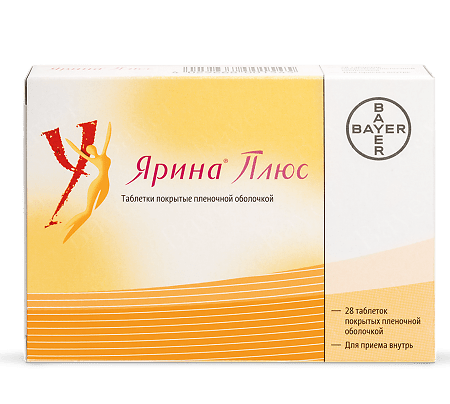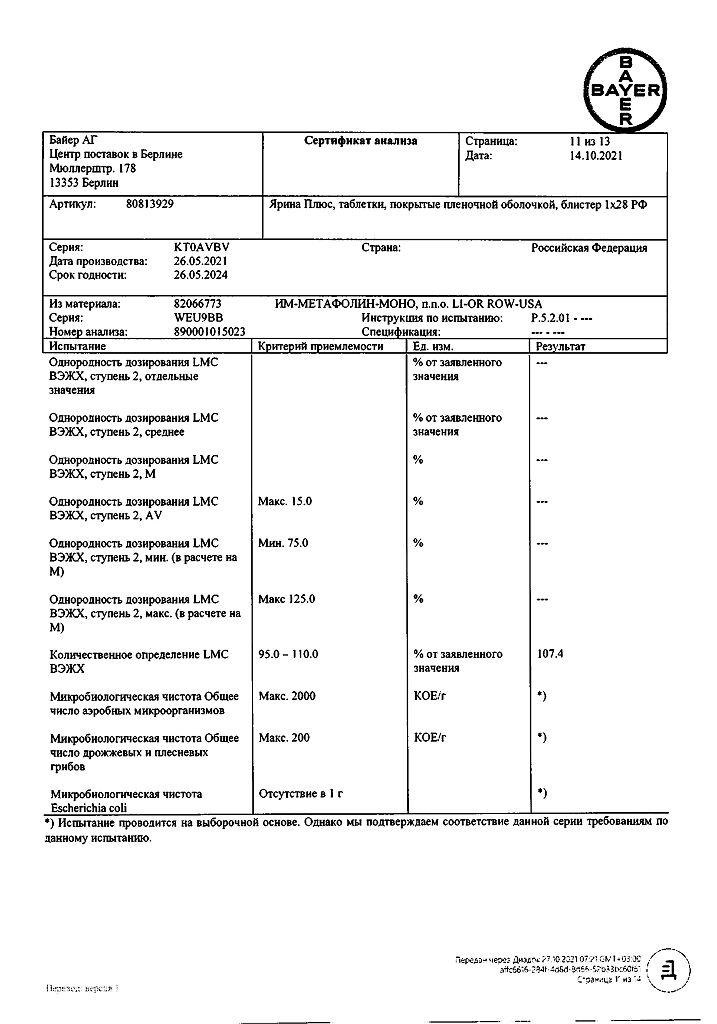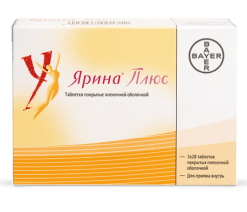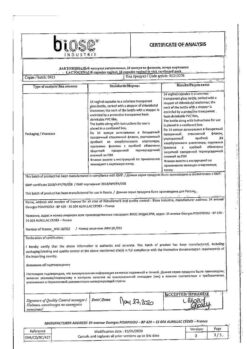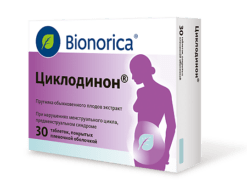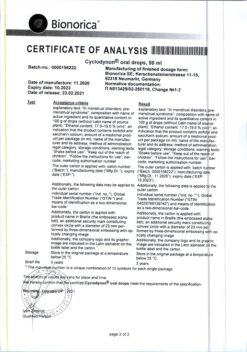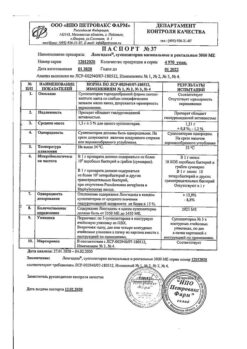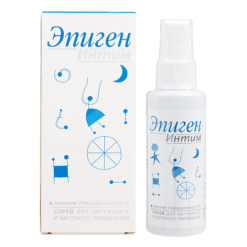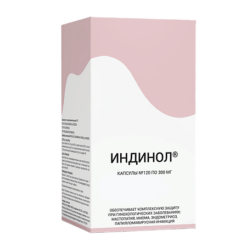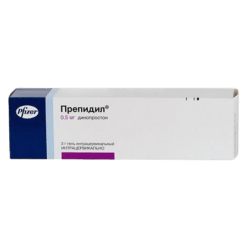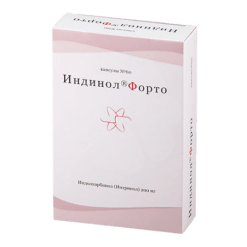Subtotal: €16.97
Yarina Plus, 28 pcs.
€38.32 €33.21
Yarina Plus is a low-dose monophasic oral combined estrogen-gestogen contraceptive drug including the active pills and auxiliary vitamin pills containing calcium levomepholate.
The contraceptive effect of Yarina Plus is mainly due to suppression of ovulation and increased viscosity of cervical mucus.
In women taking combined oral contraceptives (OCs) the cycle becomes more regular, pain, intensity and duration of menstrual bleeding decrease, and as a result the risk of iron deficiency anemia decreases. There is also evidence of a decreased risk of endometrial and ovarian cancer.
Drospirenone contained in the preparation Yarina Plus has antimineralocorticoid action and helps prevent hormone-dependent fluid retention, which may be manifested as a decrease in body weight and a decrease in the likelihood of peripheral edema.
Drospirenone also has anti-androgenic activity and helps to reduce acne (acne), oily skin and hair. This effect of drospirenone is similar to the effect of natural progesterone produced in the female body. This should be considered when choosing a contraceptive, especially for women with hormone-dependent fluid retention, as well as women with acne and seborrhea. When used correctly, the Perl Index (a measure of the number of pregnancies in 100 women using the contraceptive in a year) is less than 1. If the pill is missed or used incorrectly, the Perl Index may increase.
Calcium levomefolate. The acidic form of calcium levomepholate, is identical in structure to naturally occurring L-5-methyltetrahydrofolate (L-5-methyl-TGF), the major folate form found in food. The average plasma concentration in people who do not use foods fortified with folic acid is about 15 nmol/L. Levomefolate, in contrast to folic acid, is a biologically active form of folate.
This allows it to be absorbed better than folic acid. Levomefolate is indicated to meet the increased need and to ensure the necessary content of folate in women during pregnancy and while breastfeeding. The addition of calcium levomepholate to an oral contraceptive reduces the risk of fetal neural tube defects if a woman becomes pregnant unexpectedly, immediately after discontinuation of contraception (or, in very rare cases, when oral contraception is used).
Pharmacokinetics
Drospirenone
Intake
Drospirenone is quickly and almost completely absorbed after oral administration. After a single oral dose the Cmax of drospirenone in blood plasma is 37 ng/ml and is reached after 1-2 hours. Bioavailability ranges from 76 to 85%. Compared with the intake of drospirenone on an empty stomach, food intake does not affect its bioavailability.
Distribution
Drospirenone binds to serum albumin and does not bind to sex hormone-binding globulin (hSPH) or corticosteroid-binding globulin (CRBG). Only 3-5% of the total serum concentration of the substance is present as free hormone. Ethinylestradiol-induced increase in hGH does not affect the binding of drospirenone by plasma proteins. Mean apparent Vd is 3.7±4.2 L/kg.
The concentration of hGDP has no effect on the pharmacokinetics of drospirenone. With daily use of the drug orally, the plasma concentration of drospirenone increases by 2-3 times; the equilibrium state is reached in the second half of the cycle treatment.
Metabolism
Drospirenone is extensively metabolized after oral administration. Most metabolites in plasma are represented by acidic forms of drospirenone, which are formed without involvement of the cytochrome P450 system. According to in vitro studies, cytochrome P450 isoenzyme 3A4 is minimally involved in the metabolism of drospirenone. In concomitant use with ethinylestradiol, no interaction has been found.
The clearance of drospirenone is 1.2-1.5 ml/min/kg. The plasma concentration of drospirenone decreases in 2 phases. T1/2 of drospirenone in the second phase is about 31 h. Drospirenone is not excreted unchanged. Its metabolites are excreted through the gastrointestinal tract and the kidneys in a ratio of about 1.2:1.4. The T1/2 of metabolites is about 1.7 days.
Pharmacokinetics in special clinical cases
The plasma concentrations of drospirenone at equilibrium were comparable in women with mild renal impairment (CK 50-80 ml/min) and in women with preserved renal function (CK greater than 80 ml/min). However, in women with moderate renal impairment (CKR 30-50 ml/min), mean plasma concentration of drospirenone was 37% higher than in patients with preserved renal function. No change in plasma potassium concentrations was noted with drospirenone.
In women with moderate hepatic impairment (class B according to Child-Pugh scale) AUC is comparable to the corresponding value in healthy women with similar values of Cmax during absorption and distribution phases. The T1/2 of drospirenone in patients with moderate hepatic impairment was 1.8 times higher than in healthy volunteers with preserved hepatic function.
In patients with moderate hepatic impairment a decrease in clearance of drospirenone of about 50% was observed compared to women with preserved hepatic function, and no differences in plasma potassium concentration in the studied groups were noted. No changes in potassium concentration were noted even in case of a combination of factors predisposing to its increase (concomitant diabetes mellitus or spironolactone treatment). Tolerability of drospirenone in women with mild to moderate hepatic impairment is good (Child-Pugh grade B).
Ethinylestradiol
Intake
Ethinylestradiol is quickly and completely absorbed after oral administration. Cmax is about 54-100 pg/mL and is reached within 1-2 hours. The drug undergoes presystemic metabolism in liver, its bioavailability when administered orally is on the average about 45% with high interindividual variability – from 20 to 65%. Simultaneous intake of food in some cases is accompanied by a decrease in bioavailability of ethinylestradiol by 25%.
Distribution
Ethinylestradiol has a nonspecific but strong binding to plasma albumin (about 98%) and induces an increase in plasma concentration of hGH. The estimated Vd is about 2.8-8.6 L/kg.
The equilibrium state is reached in the second half of the treatment course when the plasma concentration of ethinylestradiol is increased by 40-110% compared to a single dose.
Metabolism
Ethinylestradiol undergoes presystemic conjugation in the liver and in the small intestinal mucosa. The main route of metabolism of ethinylestradiol is aromatic hydroxylation with the formation of numerous metabolites, which are in both bound (with glucuronides and sulfate) and unbound state. The excretion rate of ethinylestradiol is about 2.3-7 ml/min/kg.
Elimination
Ethinylestradiol is excreted only as metabolites by the kidneys and through the gastrointestinal tract at a ratio of 4:6. The T1/2 of ethinylestradiol is about 24 hours.
Pharmacokinetics in Special Clinical Cases
The effect of ethnicity on pharmacokinetic parameters has been studied in studies of single and multiple dosing of drospirenone and ethinylestradiol in healthy Caucasian women as well as in Japanese women. No effect of ethnicity on the pharmacokinetic parameters of drospirenone and ethinylestradiol was found.
Calcium levomepolate
Intake
After oral administration, calcium levomepolate is rapidly absorbed and incorporated into the body’s folate pool. After a single oral dose of 451 mcg of calcium levomepholate in 0.5-1.5 h, the Cmax becomes 50 nmol/L higher than the initial concentration.
Distribution
The pharmacokinetics of folate has a biphasic character: a pool of folate with rapid and slow metabolism is defined. Pool with fast metabolism, probably, is represented by folate newly arrived in organism that is coordinated with T1/2 of calcium of levomepolate, which is about 4-5 hours after its single intake in dose of 451 mcg. The slow metabolism pool reflects the conversion of polyglutamate folate, the T1/2 of which is about 100 days. Externally supplied folate and folate passing through the intestinal-hepatic cycle maintain a constant concentration of L-5-methyl-TTP in the body.
L-5-methyl-TTF represents the main form of existence of folate in the body, in which it is delivered to peripheral tissues to participate in cellular folate metabolism.
The equilibrium state of L-5-methyl-THF in plasma after oral administration of 451 µg of calcium levomepolate is reached after 8-16 weeks and depends on its initial concentration. In erythrocytes, Css is reached at a later time because of the life span of erythrocytes, which is about 120 days.
Metabolism
L-5-methyl-THF represents the major plasma folate transportable form. When 451 µg of calcium levomepholate and 400 µg of folic acid were compared, similar metabolic mechanisms were established for other significant folates. Folate coenzymes are involved in 3 major conjugated cycles of metabolism in the cell cytoplasm. These cycles are essential for the synthesis of thymidine and purines, precursors of DNA and RNA acids, as well as for the synthesis of methionine from homocysteine and the conversion of serine to glycine.
Elimination
L-5-methyl-TTF is excreted by the kidneys unchanged and as metabolites, as well as through the intestine.
Indications
Contraception intended primarily for women with symptoms of hormone-dependent fluid retention in the body.
Contraception and treatment of moderate acne (acne vulgaris).
Contraception in women with folate deficiency.
Pharmacological effect
Yarina Plus is a low-dose monophasic oral combined estrogen-progestogen contraceptive drug, including active tablets and auxiliary vitamin tablets containing calcium levomefolate.
The contraceptive effect of Yarina Plus is mainly achieved by suppressing ovulation and increasing the viscosity of cervical mucus.
In women taking combined oral contraceptives (COCs), the cycle becomes more regular, the pain, intensity and duration of menstrual bleeding decrease, resulting in a reduced risk of iron deficiency anemia. There is also evidence of a reduced risk of endometrial and ovarian cancer.
Drospirenone, contained in Yarina Plus, has an antimineralocorticoid effect and helps prevent hormone-dependent fluid retention, which can manifest itself in weight loss and a reduction in the likelihood of peripheral edema.
Drospirenone also has antiandrogenic activity and helps reduce acne (blackheads), oily skin and hair. This effect of drospirenone is similar to the effect of natural progesterone produced in the female body. This should be taken into account when choosing a contraceptive, especially for women with hormone-dependent fluid retention, as well as women with acne and seborrhea. When used correctly, the Pearl index (an indicator reflecting the number of pregnancies in 100 women using a contraceptive during the year) is less than 1. If pills are missed or used incorrectly, the Pearl index may increase.
Calcium levomefolate. The acid form of calcium levomefolate is structurally identical to naturally occurring L-5-methyltetrahydrofolate (L-5-methyl-THF), the main folate form found in food. The average concentration in the blood plasma of people who do not consume foods fortified with folic acid is about 15 nmol/l. Levomefolate, unlike folic acid, is a biologically active form of folate.
Thanks to this, it is absorbed better than folic acid. Levomefolate is indicated to meet the increased need and ensure the necessary folate content in a woman’s body during pregnancy and lactation. The addition of levomefolate calcium to an oral contraceptive reduces the risk of developing a neural tube defect if a woman becomes unexpectedly pregnant immediately after stopping contraception (or, in very rare cases, when using oral contraception).
Pharmacokinetics
Drospirenone
Suction
After oral administration, drospirenone is rapidly and almost completely absorbed. After a single oral dose, the Cmax of drospirenone in the blood plasma, equal to 37 ng/ml, is achieved after 1-2 hours. Bioavailability ranges from 76 to 85%. Compared to taking drospirenone on an empty stomach, food intake does not affect its bioavailability.
Distribution
Drospirenone binds to serum albumin and does not bind to sex hormone binding globulin (SHBG) or corticosteroid binding globulin (CBG). Only 3-5% of the total serum concentration is present as free hormone. The increase in SHBG induced by ethinyl estradiol does not affect the binding of drospirenone to plasma proteins. The average apparent Vd is 3.7±4.2 l/kg.
The concentration of SHBG does not affect the pharmacokinetics of drospirenone. With daily oral use of the drug, the concentration of drospirenone in the blood plasma increases 2-3 times, an equilibrium state is achieved in the second half of the cyclic treatment.
Metabolism
After oral administration, drospirenone is extensively metabolized. Most metabolites in plasma are represented by acidic forms of drospirenone, which are formed without the involvement of the cytochrome P450 system. According to in vitro studies, cytochrome P450 isoenzyme 3A4 is involved to a minimal extent in the metabolism of drospirenone. No interaction has been established with simultaneous use with ethinyl estradiol.
Removal
The clearance of drospirenone is 1.2-1.5 ml/min/kg. The concentration of drospirenone in blood plasma decreases in 2 phases. T1/2 of drospirenone in the second phase is about 31 hours. Drospirenone is not excreted unchanged. Its metabolites are excreted through the gastrointestinal tract and kidneys in a ratio of approximately 1.2:1.4. T1/2 of metabolites is about 1.7 days.
Pharmacokinetics in special clinical situations
The concentration of drospirenone in the blood plasma when reaching a steady state was comparable in women with mild renal impairment (creatinine clearance 50-80 ml/min) and in women with preserved renal function (creatinine clearance more than 80 ml/min). However, in women with moderate renal impairment (creatinine clearance 30-50 ml/min), the average plasma concentration of drospirenone was 37% higher than in patients with preserved renal function. There were no changes in the concentration of potassium in the blood plasma when using drospirenone.
In women with moderate liver dysfunction (class B on the Child-Pugh scale), AUC is comparable to the corresponding indicator in healthy women with similar Cmax values in the absorption and distribution phases. T1/2 of drospirenone in patients with moderate liver dysfunction was 1.8 times higher than in healthy volunteers with intact liver function.
In patients with moderate liver dysfunction, a decrease in the clearance of drospirenone by about 50% was observed compared to women with preserved liver function, while there were no differences in the concentration of potassium in the blood plasma in the studied groups. There were no changes in potassium concentration even in the case of a combination of factors predisposing to its increase (concomitant diabetes mellitus or treatment with spironolactone). Drospirenone is well tolerated in women with mild to moderate liver dysfunction (Child-Pugh class B).
Ethinyl estradiol
Suction
After oral administration, ethinyl estradiol is rapidly and completely absorbed. Cmax is about 54-100 pg/ml, achieved within 1-2 hours. The drug undergoes first-pass metabolism in the liver, its bioavailability when taken orally averages about 45% with high interindividual variability – from 20 to 65%. Simultaneous ingestion of food in some cases is accompanied by a decrease in the bioavailability of ethinyl estradiol by 25%.
Distribution
Ethinyl estradiol has a nonspecific but strong binding to plasma albumin (about 98%) and induces an increase in plasma concentrations of SHBG. The estimated Vd is about 2.8-8.6 l/kg.
An equilibrium state is achieved in the second half of the course of treatment, when the concentration of ethinyl estradiol in the blood plasma increases by 40-110% compared to a single dose.
Metabolism
Ethinyl estradiol undergoes presystemic conjugation in the liver and in the mucosa of the small intestine. The main metabolic pathway of ethinyl estradiol is aromatic hydroxylation with the formation of numerous metabolites, which are found in both bound (with glucuronides and sulfate) and unbound states. The rate of elimination of ethinyl estradiol is about 2.3-7 ml/min/kg.
Removal
Ethinyl estradiol is excreted only in the form of metabolites by the kidneys and through the gastrointestinal tract in a ratio of 4:6. T1/2 of ethinyl estradiol is about 24 hours.
Pharmacokinetics in special clinical situations
The effect of ethnicity on pharmacokinetic parameters was studied in single and multiple dose studies of drospirenone and ethinyl estradiol in healthy Caucasian and Japanese women. The influence of ethnicity on the pharmacokinetic parameters of drospirenone and ethinyl estradiol has not been established.
Calcium levomefolate
Suction
After oral administration of calcium, levomefolate is rapidly absorbed and included in the body’s folate pool. After a single oral dose of 451 mcg of calcium levomefolate, after 0.5-1.5 hours, Cmax becomes 50 nmol/l higher than the initial concentration.
Distribution
The pharmacokinetics of folates has a two-phase character: a pool of folates with fast and slow metabolism is determined. The rapidly metabolized pool likely represents newly absorbed folate, which is consistent with the T1/2 of levomefolate calcium, which is approximately 4-5 hours after a single oral dose of 451 mcg. The slow metabolizing pool reflects the conversion of folate polyglutamate, whose T1/2 is about 100 days. Folates coming from outside and folates passing through the enterohepatic cycle ensure the maintenance of a constant concentration of L-5-methyl-TTP in the body.
L-5-methyl-THF represents the main form of existence of folates in the body, in which they are delivered to peripheral tissues to participate in cellular folate metabolism.
The equilibrium state of L-5-methyl-THF in the blood plasma after oral administration of 451 mcg of calcium levomefolate is achieved after 8-16 weeks and depends on its initial concentration. In red blood cells, Css is achieved at a later date due to the lifespan of red blood cells, which is about 120 days.
Metabolism
L-5-methyl-THF is the main transported form of folate in plasma. When comparing 451 mcg calcium levomefolate and 400 mcg folic acid, similar metabolic mechanisms were established for other significant folates. Folate coenzymes are involved in 3 main coupled metabolic cycles in the cytoplasm of cells. These cycles are necessary for the synthesis of thymidine and purines, precursors of DNA and RNA acids, as well as for the synthesis of methionine from homocysteine and the conversion of serine to glycine.
Removal
L-5-methyl-TTP is excreted by the kidneys unchanged and in the form of metabolites, as well as through the intestines.
Special instructions
If any of the conditions, diseases and risk factors listed below currently exist, the potential risks and expected benefits of using Yarina Plus should be carefully weighed in each individual case and discussed with the woman before she decides to start taking this drug.
Diseases of the cardiovascular system
The results of epidemiological studies indicate a relationship between the use of COCs and an increased incidence of venous and arterial thrombosis and thromboembolism (such as deep vein thrombosis, pulmonary embolism, myocardial infarction, cerebrovascular disorders) when taking combined oral contraceptives. These diseases are rare.
The risk of developing venous thromboembolism (VTE) is greatest in the first year of taking such drugs. An increased risk is present after initial use of combined oral contraceptives or resumption of use of the same or different combined oral contraceptives (after a dosing interval of 4 weeks or more). Data from a large prospective study involving 3 groups of patients suggest that this increased risk is predominantly present during the first 3 months.
Overall risk of venous thromboembolism VTE in patients taking low-dose combined oral contraceptives (
Data from a large prospective study involving 3 groups of patients show that in women with or without risk factors for VTE using ethinyl estradiol/drospirenone-containing contraceptives at a dosage of 0.03 mg/3 mg, respectively, the incidence of VTE is the same as when using levonorgestrel-containing oral contraceptives.
VTE can be life-threatening or fatal (in 1-2% of cases).
VTE, manifested as deep vein thrombosis or pulmonary embolism, can occur with the use of any combined oral contraceptives.
It is extremely rare that when using combined oral contraceptives, thrombosis of other blood vessels occurs, for example, hepatic, mesenteric, renal, cerebral veins and arteries or retinal vessels. There is no consensus regarding the relationship between the occurrence of these events and the use of combined oral contraceptives.
Symptoms of deep vein thrombosis (DVT): unilateral swelling of the lower extremity or along a vein of the lower extremity, pain or discomfort in the lower extremity only in an upright position or when walking, local increase in temperature in the affected lower extremity, redness or discoloration of the skin on the lower extremity.
Symptoms of pulmonary embolism (PE): difficulty or rapid breathing; sudden cough, incl. with hemoptysis; sharp pain in the chest, which may intensify with deep inspiration; feeling of anxiety; severe dizziness; fast or irregular heartbeat. Some of these symptoms (eg, shortness of breath, cough) are nonspecific and may be misinterpreted as signs of other more or less severe events (eg, respiratory tract infection).
Arterial thromboembolism can lead to stroke, vascular occlusion, or myocardial infarction. Symptoms of a stroke: sudden weakness or loss of sensation in the face, upper or lower extremities, especially on one side of the body, sudden confusion, problems with speech and comprehension; sudden unilateral or bilateral vision loss; sudden disturbance in gait, dizziness, loss of balance or coordination; sudden, severe or prolonged headache for no apparent reason; loss of consciousness or fainting with or without an epileptic seizure. Other signs of vascular occlusion: sudden pain, swelling and slight blue discoloration of the extremities, acute abdomen.
Symptoms of myocardial infarction: pain, discomfort, pressure, heaviness, a feeling of squeezing or fullness in the chest, arm or chest; discomfort radiating to the back, cheekbone, larynx, arm, stomach; cold sweat, nausea, vomiting or dizziness, severe weakness, anxiety or shortness of breath; fast or irregular heartbeat.
Arterial thromboembolism can be life-threatening or fatal.
The risk of developing thrombosis (venous and/or arterial) and thromboembolism increases:
– with age;
– in smokers (with an increase in the number of cigarettes or an increase in age, the risk increases, especially in women over 35 years of age);
if available:
— obesity (BMI more than 30 kg/m2);
– family history (for example, venous or arterial thromboembolism ever in close relatives or parents at a relatively young age). In the case of a hereditary or acquired predisposition, the woman should be examined by an appropriate specialist to decide on the possibility of taking the drug Yarina Plus;
– prolonged immobilization, major surgery, any operation on the lower extremities or major trauma. In these situations, it is advisable to stop using the drug Yarina Plus (in the case of a planned operation, at least 4 weeks before it) and not to resume taking it for 2 weeks after the end of immobilization;
– dislipoproteinemia;
– arterial hypertension;
– migraine;
— diseases of the heart valves;
– atrial fibrillation.
The possible role of varicose veins and superficial thrombophlebitis in the development of venous thromboembolism remains controversial.
The increased risk of thromboembolism in the postpartum period should be taken into account.
Peripheral circulatory disorders may also occur in diabetes mellitus, systemic lupus erythematosus, hemolytic uremic syndrome, chronic inflammatory bowel disease (Crohn’s disease or ulcerative colitis) and sickle cell anemia.
An increase in the frequency and severity of migraines during use of Yarina Plus (which may precede cerebrovascular events) may be grounds for immediate discontinuation of this drug.
Biochemical indicators indicating a hereditary or acquired predisposition to venous or arterial thrombosis include the following: resistance to activated protein C, hyperhomocysteinemia, antithrombin III deficiency, protein C deficiency, protein S deficiency, antiphospholipid antibodies (anticardiolipin antibodies, lupus anticoagulant).
When assessing the risk-benefit ratio, it should be taken into account that adequate treatment of the relevant condition may reduce the associated risk of thrombosis. It should also be taken into account that the risk of thrombosis and thromboembolism during pregnancy is higher than when taking low-dose oral contraceptives (<50 mcg ethinyl estradiol).
Tumors
The most significant risk factor for developing cervical cancer is persistent human papillomavirus infection. There are reports of a slight increase in the risk of developing cervical cancer with long-term use of COCs. However, the connection with taking COCs has not been proven. The possibility of the relationship of these data with screening for cervical diseases and with characteristics of sexual behavior (less frequent use of barrier methods of contraception) is discussed.
A meta-analysis of 54 epidemiological studies showed that there is a slightly increased relative risk of developing breast cancer diagnosed in women currently taking COCs (relative risk 1.24). The increased risk gradually disappears within 10 years of stopping these drugs. Because breast cancer is rare in women under 40 years of age, the increase in breast cancer diagnoses in women who are currently or recently taking COCs is small relative to the overall risk of breast cancer. Its connection with the use of COCs has not been proven. The observed increased risk may be a consequence of careful monitoring and earlier diagnosis of breast cancer in women using COCs. Women who have ever used COCs are diagnosed with earlier stages of breast cancer than women who have never used them.
In rare cases, during the use of COCs, the development of benign, and in extremely rare cases, malignant liver tumors was observed, which in some patients led to life-threatening intra-abdominal bleeding.
If severe abdominal pain, liver enlargement, or signs of intra-abdominal bleeding occur, this should be taken into account when making a differential diagnosis.
Other states
Clinical studies have shown no effect of drospirenone on plasma potassium concentrations in patients with mild to moderate renal failure. However, in patients with impaired renal function and an initial potassium concentration at the upper limit of normal, the risk of developing hyperkalemia cannot be excluded while taking medications that lead to potassium retention in the body.
Women with hypertriglyceridemia (or a family history of this condition) may have an increased risk of developing pancreatitis while taking COCs.
Although slight increases in blood pressure have been described in many women taking COCs, clinically significant increases have rarely been observed. However, if a persistent, clinically significant increase in blood pressure develops while taking Yarina Plus, this drug should be discontinued and treatment of arterial hypertension should be started. The drug can be continued if normal blood pressure values are achieved with antihypertensive therapy.
The following conditions have been reported to develop or worsen both during pregnancy and while taking COCs, but their association with COC use has not been proven: jaundice and/or pruritus associated with cholestasis; formation of gallstones; porphyria; systemic lupus erythematosus: hemolytic-uremic syndrome; Sydenham’s chorea; herpes during pregnancy; hearing loss associated with otosclerosis. Cases of Crohn’s disease and ulcerative colitis have also been described with the use of COCs.
In women with hereditary forms of angioedema, exogenous estrogens may cause or worsen symptoms of angioedema.
Acute or chronic liver dysfunction may require discontinuation of Yarina Plus until liver function tests return to normal. Recurrent cholestatic jaundice, which develops for the first time during pregnancy or previous use of sex hormones, requires discontinuation of the drug Yarina Plus.
Although COCs may have an effect on insulin resistance and glucose tolerance, there is no need to change the therapeutic regimen in diabetic patients using Yarina Plus. However, women with diabetes should be closely monitored while taking this drug.
Chloasma can sometimes develop, especially in women with a history of chloasma during pregnancy. Women with a tendency to chloasma while taking Yarina Plus should avoid prolonged exposure to the sun and exposure to ultraviolet radiation.
Folates may mask vitamin B12 deficiency.
Preclinical safety data
Preclinical data from routine repeated-dose toxicity, genotoxicity, carcinogenicity and reproductive toxicity studies do not indicate a particular risk to humans. However, it should be remembered that sex hormones can promote the growth of certain hormone-dependent tissues and tumors.
Preclinical data from routine studies of levomefolate calcium for repeated dose toxicity, genotoxicity and reproductive toxicity do not indicate a particular risk to humans.
Laboratory tests
Taking Yarina Plus may affect the results of some laboratory tests, including indicators of liver, kidney, thyroid, adrenal function, the concentration of transport proteins in plasma, indicators of carbohydrate metabolism, parameters of blood coagulation and fibrinolysis. Changes usually do not go beyond normal values. Drospirenone increases plasma renin activity and aldosterone concentrations, which is associated with its antimineralocorticoid effect.
There is a theoretical possibility of increasing the concentration of potassium in the blood plasma in women receiving Yarina Plus simultaneously with other drugs that can increase the content of potassium in the blood plasma. These drugs include angiotensin II receptor antagonists, potassium-sparing diuretics, and aldosterone antagonists. However, in studies evaluating the interaction of drospirenone with ACE inhibitors or indomethacin, there was no significant difference in plasma potassium concentrations compared with placebo.
Reduced efficiency
The effectiveness of Yarina Plus may be reduced in the following cases: if tablets are missed, with vomiting and diarrhea, or as a result of drug interactions.
Frequency and severity of menstrual bleeding
While taking the drug Yarina Plus, irregular (acyclic) spotting and bleeding from the vagina (spotting or “breakthrough” uterine bleeding) may occur, especially during the first months of use. Therefore, any irregular bleeding should be assessed after an adaptation period of approximately 3 cycles.
If irregular bleeding recurs or develops after previous regular cycles, careful evaluation should be performed to rule out malignancy or pregnancy.
Some women may not develop withdrawal bleeding while off the pill. If Yarina Plus was taken as recommended, it is unlikely that the woman is pregnant. However, if the drug Yarina Plus is not used regularly and there are no two consecutive withdrawal bleedings, the drug cannot be continued until pregnancy has been ruled out.
Medical examinations
Before starting or resuming use of the drug, it is necessary to familiarize yourself with the woman’s life history, family history, conduct a thorough physical examination (including measuring blood pressure, heart rate, determining body mass index, examining the mammary glands), gynecological examination, cytological examination of the cervix (Papanicolaou test), and exclude pregnancy. When resuming taking the drug Yarina Plus, the volume of additional studies and the frequency of control examinations are determined individually, but at least once every 6 months.
The woman should be warned that Yarina Plus does not protect against HIV infection and other sexually transmitted diseases.
Impact on the ability to drive vehicles and operate machinery
There have been no reported cases of adverse effects of the drug Yarina Plus on the speed of psychomotor reactions; No studies have been conducted to study the effect of the drug on the speed of psychomotor reactions.
Active ingredient
Drospirenone, Ethinyl estradiol, Calcium Levomefolinate
Composition
Film-coated tablets (active combination)
1 tablet contains:
active substances:
ethinyl estradiol (micronized, in the form of betadex clathrate) 30 mcg,
drospirenone (micronized) 3 mg,
calcium levomefolate (micronized) 451 mcg
excipients:
lactose monohydrate – 45.319 mg,
microcrystalline cellulose – 24.8 mg,
croscarmellose sodium – 3.2 mg,
hyprolose (5 cP) – 1.6 mg,
magnesium stearate – 1.6 mg.
shell composition:
orange varnish – 2 mg or (alternatively): hypromellose (5 cP) – 1.0112 mg, macrogol 6000 – 202.4 mcg, talc – 202.4 mcg, titanium dioxide – 527.1 mcg, iron oxide yellow – 44.6 mcg, iron oxide red dye – 12.3 mcg.
Film-coated tablets (vitamin supplements)
1 tablet contains:
active substances:
calcium levomefolate (micronized) 451 mg
excipients:
lactose monohydrate – 48.349 mg,
microcrystalline cellulose – 24.8 mg,
croscarmellose sodium – 3.2 mg,
hyprolose (5 cP) – 1.6 mg,
magnesium stearate – 1.6 mg.
shell composition:
light orange varnish – 2 mg or (alternatively): hypromellose (5 cP) – 1.0112 mg, macrogol 6000 – 202.4 mcg, talc – 202.4 mcg, titanium dioxide – 572.3 mcg, iron oxide yellow – 8.9 mcg, iron oxide red dye – 2.8 mcg.
Pregnancy
The drug is contraindicated during pregnancy. If pregnancy is detected while taking Yarina Plus, the drug should be discontinued immediately.
Data on the results of taking the drug Yarina Plus during pregnancy are limited and do not allow us to draw any conclusions about the negative impact of the drug on pregnancy, the health of the fetus and newborn child.
At the same time, extensive epidemiological studies have not revealed an increased risk of developmental defects in children born to women who took COCs before pregnancy or teratogenic effects in cases of inadvertent use of COCs in early pregnancy.
Specific epidemiological studies have not been conducted on the drug Yarina Plus.
The drug is contraindicated during breastfeeding. Taking COCs can reduce the amount of breast milk and change its composition, so their use is not recommended until you stop breastfeeding.
Small amounts of sex hormones and/or their metabolites may be excreted in milk, but there is no evidence of their negative effects on the health of the child.
Contraindications
Yarina Plus is contraindicated in the presence of any of the conditions/diseases listed below. If any of these conditions/diseases develop for the first time while taking the drug, the drug should be discontinued immediately.
Thrombosis (venous and arterial) and thromboembolism currently or in history (including deep vein thrombosis, pulmonary embolism, myocardial infarction, stroke), cerebrovascular disorders.
Conditions preceding thrombosis (including transient ischemic attacks, angina) currently or in history.
The presence of multiple or severe risk factors for venous or arterial thrombosis.
Migraine with focal neurological symptoms currently or in history.
Diabetes mellitus with vascular complications.
Liver failure and severe liver diseases (until liver tests normalize).
Severe and/or acute renal failure.
Liver tumors (benign or malignant) currently or in history.
Detected hormone-dependent malignant neoplasms (including genitals or mammary glands) or suspicion of them.
Bleeding from the vagina of unknown origin.
Pregnancy or suspicion of it.
Breastfeeding period.
Hypersensitivity or intolerance to any of the components of the drug Yarina Plus.
Yarina Plus contains lactose and is therefore contraindicated in patients with rare hereditary lactose intolerance, lactase deficiency or glucose-galactose malabsorption.
Side Effects
From the digestive system: nausea, vomiting.
From the reproductive system: changes in vaginal secretion.
From the endocrine system: engorgement, soreness of the mammary glands, secretion from them; change in body weight, change in libido.
From the central nervous system: decreased mood, headache, migraine.
Other: various skin reactions, poor tolerance of contact lenses, fluid retention in the body, allergic reactions.
Interaction
Interaction of oral contraceptives with other drugs may lead to breakthrough uterine bleeding and/or decreased contraceptive reliability.
Interactions leading to a decrease in the effectiveness of the drug Yarina Plus
Effect on hepatic metabolism: the use of drugs that induce liver microsomal enzymes can lead to an increase in the clearance of sex hormones. Such drugs include: phenytoin, barbiturates, primidone, carbamazepine, rifampicin, possibly also oxcarbazepine, topiramate, felbamate, griseofulvin and preparations containing St. John’s wort. HIV protease inhibitors (eg, ritonavir) and non-nucleoside reverse transcriptase inhibitors (eg, nevirapine) and combinations thereof also have the potential to affect hepatic metabolism.
Effect on enterohepatic recirculation: According to individual studies, some antibiotics (for example, penicillins and tetracyclines) may reduce the enterohepatic recirculation of estrogens, thereby reducing the concentration of ethinyl estradiol.
While taking medications that affect liver microsomal enzymes, and for 28 days after their discontinuation, a barrier method of contraception should be additionally used.
Effect on enterohepatic recirculation: According to individual studies, some antibiotics (for example, penicillins and tetracyclines) may reduce the enterohepatic recirculation of estrogens, thereby reducing the concentration of ethinyl estradiol.
While taking medications that affect liver microsomal enzymes, and for 28 days after their discontinuation, a barrier method of contraception should be additionally used.
While taking antibiotics (except for rifampicin and griseofulvin) and for 7 days after their discontinuation, a barrier method of contraception should be additionally used. If the period of use of the barrier method of contraception ends later than the hormone-containing orange tablets in the package, you should skip taking the remaining auxiliary light orange tablets and start taking Yarina Plus from a new package without interruption in taking the tablets.
Interactions that reduce the effectiveness of calcium levomefolate
Effect on folate metabolism: Some drugs reduce blood folate concentrations or reduce the effectiveness of levomefolate calcium by inhibiting the enzyme dihydrofolate reductase (for example, methotrexate, trimethoprim, sulfasalazine and triamterene) or by reducing the absorption of folate (for example, cholestyramine) or through unknown mechanisms (for example, antiepileptic drugs: carbamazepine, phenytoin, phenobarbital, primidone and valproic acid).
Effect on metabolism of COCs (enzyme inhibitors)
The main metabolites of drospirenone are formed in plasma without the participation of the cytochrome P450 system. Therefore, the effect of inhibitors of the cytochrome P450 system on the metabolism of drospirenone is unlikely.
Effect of COCs or calcium levomefolate on the activity of other drugs
COCs may affect the metabolism of other drugs, leading to an increase (for example, cyclosporine) or a decrease (for example, lamotrigine) in their plasma and tissue concentrations.
Based on interaction studies, as well as studies in female volunteers taking omeprazole, simvastatin and midazolam as test substrates, it can be concluded that the effect of drospirenone 3 mg on the metabolism of other drugs is unlikely.
Folates may alter the pharmacokinetics or pharmacodynamics of some drugs that affect folate metabolism. for example, antiepileptic drugs (phenytoin), mstotrexate or pyrimethamine. which may be accompanied by a decrease (mostly reversible, provided the dose of the drug affecting folate metabolism is increased) of their therapeutic effect. The administration of folate during treatment with such drugs is recommended mainly to reduce the toxicity of the latter.
Overdose
There have been no cases of overdose of Yarina Plus reported.
Symptoms that may occur in case of overdose: nausea, vomiting, spotting vaginal discharge or metrorrhagia (more often in young women).
Treatment: there is no specific antidote; symptomatic treatment should be carried out. Calcium levomefolate and its metabolites are identical to folates that are part of natural products, the daily consumption of which does not harm the body. Taking calcium levomefolate at a dose of 17 mg/day (the dose is 37 times higher than that contained in 1 tablet of Yarina Plus) for 12 weeks was well tolerated.
Storage conditions
At a temperature not exceeding 25 °C
Shelf life
3 years
Manufacturer
Bayer Weimar GmbH & Co. KG, Germany
| Shelf life | 3 years |
|---|---|
| Conditions of storage | At a temperature not exceeding 25 °C |
| Manufacturer | Bayer Weimar GmbH & Co. KG, Germany |
| Medication form | tablet set |
| Brand | Bayer Weimar GmbH & Co. KG |
Other forms…
Related products
Gynecology and Obstetrics
Gynecology and Obstetrics
Prepidil, intracervical gel 0.5 mg/3 g syringes with catheter
Buy Yarina Plus, 28 pcs. with delivery to USA, UK, Europe and over 120 other countries.


